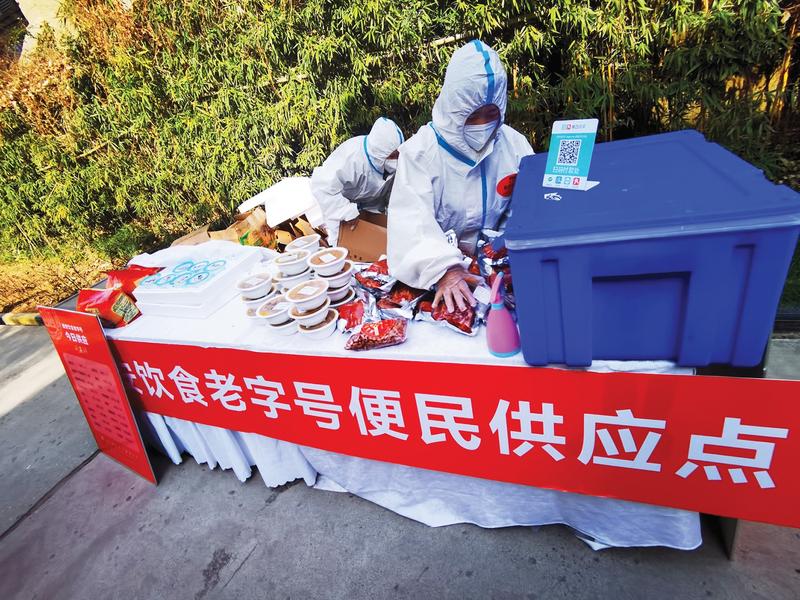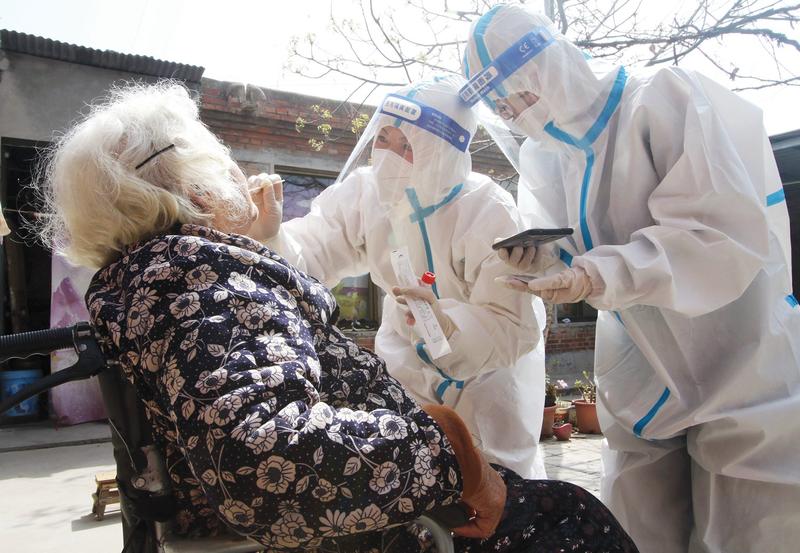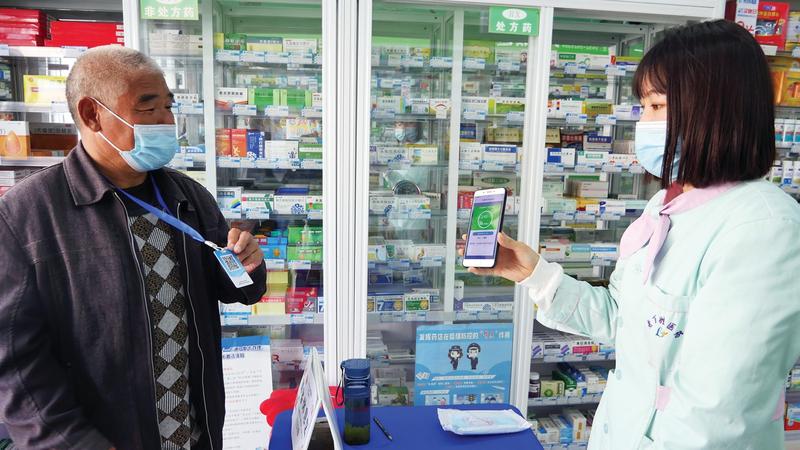 Volunteers unload and disinfect some 40 cartons of watermelons at a residential compound in Shanghai’s Changning district on April 24. Designated as a precautionary-level area, residents have been ordering groceries via group purchases organized by community workers for weeks. (ZHU XINGXIN / CHINA DAILY)
Volunteers unload and disinfect some 40 cartons of watermelons at a residential compound in Shanghai’s Changning district on April 24. Designated as a precautionary-level area, residents have been ordering groceries via group purchases organized by community workers for weeks. (ZHU XINGXIN / CHINA DAILY)
With a large population of unvaccinated seniors and an already stretched healthcare workforce, Shanghai cannot afford to relax its COVID-19 measures as it battles a severe wave of the Omicron variant, according to experts.
There could be severe consequences if the city deviated from the “dynamic zero-COVID strategy”, including surging numbers of severe cases and deaths among the elderly, with hospitals overburdened, the experts said.
Given Shanghai’s pivotal role in regional development, such negative effects would inevitably extend beyond the city and affect neighboring provinces and even farther afield, they added.
Since late February, Shanghai has reported more than 500,000 COVID-19 infections, with the number of daily cases topping 15,000 for weeks. With an approach aimed at stemming the spread of the virus in the shortest possible time, some areas have entered their fifth week of lockdown.
Zhang Wenhong, head of the infectious disease department at Huashan Hospital affiliated to Fudan University in Shanghai, said during a forum on April 21: “The Omicron strain is indeed a formidable enemy … What we continue to be most worried about, and what we cannot let go, are the elderly and vulnerable populations, who are not rid of the grim risk posed by the virus.”
 Restaurants set up a food stand at a neighborhood under lockdown in Xi’an, Shaanxi province, in January. (YANG YONGQIAN / FOR CHINA DAILY)
Restaurants set up a food stand at a neighborhood under lockdown in Xi’an, Shaanxi province, in January. (YANG YONGQIAN / FOR CHINA DAILY)
Some 23.4 percent of Shanghai’s population is age 60 or older, compared with a national average of 18.7 percent. The city’s elderly population alone — about 5.8 million people — is more than the entire population of Singapore, official data show.
However, as of April 15, only 62 percent of seniors in Shanghai were fully vaccinated, while 38 percent had received a booster shot, local health authorities said. Singapore, by the middle of April, had fully vaccinated more than 95 percent of people age 60 or older, according to public data.
Xu Gang, associate professor at Shanghai Jiao Tong University’s School of Public Health, told Jiefang Daily: “Even though many people infected with Omicron only exhibit mild symptoms, research data has shown that the variant can seriously harm the elderly, especially those who are unvaccinated. It is absolutely not a seasonal flu of a larger size.”
Without “lightning fast” measures to curb the virus’ spread, a large number of severe cases and deaths would occur among seniors and exert “unendurable pain on families and society”, Xu said.
In Hong Kong, the heavy toll taken by a fifth wave of COVID-19 has served as a sobering reminder of the threat posed by the Omicron variant.
In a study released on April 14, researchers from the University of Hong Kong concluded that the fast spread of Omicron and low vaccination coverage among the elderly had resulted in a staggeringly high death count — more than 8,000 — in the city.
 A senior undergoes a nucleic acid test at home in Handan, Hebei province. (HU GAOLEI / FOR CHINA DAILY)
A senior undergoes a nucleic acid test at home in Handan, Hebei province. (HU GAOLEI / FOR CHINA DAILY)
Death toll rising
Even though the strain appears to be milder, the university found that in Hong Kong, the fatality risk for unvaccinated Omicron cases during the early stages of the fifth wave was nearly identical to that for patients infected during earlier waves.
The death toll in Shanghai is rising. As of April 24, the city had reported 138 COVID-19 deaths, 196 severe cases and 23 critical cases, mainly among unvaccinated seniors with underlying illnesses.
Xu said: “Throughout China, at least 40 million seniors have not been fully inoculated. Door-to-door vaccination services are suggested as a means to boost immunization among this age group. For Shanghai, we also need to devote more efforts to raising the vaccination rate among the elderly.”
Ma Xiaowei, minister of the National Health Commission, said in a signed article on April 18 that China’s medical resources are insufficient in general and could collapse if the virus runs rampant.
Data from the commission show there were 2.9 doctors and 3.34 nurses per 1,000 people in 2020, lagging behind a number of developed countries, including Australia, which had 3.8 doctors and 12 nurses per 1,000 people.
Du Bin, vice-president of Peking Union Medical College Hospital and a critical care specialist, said in a study published in June that China only had 3.6 intensive care unit beds per 100,000 people, compared with 34.7 such beds in the United States and 29.2 in Germany.
“There was a large gap between critical care delivery and demand,” he said in the co-authored article, adding that the lack of professional critical care health workers further strained capacity.
Shanghai, which is home to renowned hospitals and top medical professionals, has had to seek help from outside amid the current outbreak.
Jiao Yahui, head of the National Health Commission’s medical administration bureau, said that as of April 4,
more than 38,000 medical workers from 15 provincial-level regions had been sent to the city to help fight the virus.
 Green channels are provided for students receiving nucleic acid tests in Qingdao, Shandong province. (LI ZIHENG / XINHUA)
Green channels are provided for students receiving nucleic acid tests in Qingdao, Shandong province. (LI ZIHENG / XINHUA)
In a sign of the increasing pressure on designated hospitals, the city announced last week that 6,700 beds in makeshift facilities initially designed to receive asymptomatic or mild cases would be upgraded to accommodate patients with moderate symptoms of COVID-19.
Liang Wanxian, an expert with the commission’s virus response task force, said on April 22 that relaxing COVID-19 control at present would trigger a “vicious circle”. The surging number of severe cases could collapse the medical system and lead to cross-infection among health workers, hampering the provision of other medical services.
Experts said that as Shanghai is a major transportation hub, COVID-19 cases in the city may spill over to other parts of the country. As a result, it is crucial to uphold dynamic clearance and for the outbreak to be brought under control as soon as possible to reduce its impact.
Shanghai, the nation’s financial powerhouse, has one of China’s most developed and interconnected public transportation systems. As of the end of 2020, the city operated 1,585 public transportation routes with a total length of 9,116 kilometers, according to the Information Office of Shanghai Municipality.
Moreover, Shanghai has 14 municipal highways and seven national expressways connecting to other big cities, including Beijing, Xi’an, capital of Shaanxi province, and Kunming, the Yunnan provincial capital. Shanghai also has 67 roads leading to the neighboring provinces of Jiangsu and Zhejiang.
Shanghai Pudong International Airport is one of the busiest in China. In 2019, it handled more than 76 million travelers, 511,840 flights and over 3.6 million metric tons of cargo.
Xu, from Shanghai Jiao Tong University, said that if the city cannot achieve dynamic clearance of cases, the virus may spill over through human transmission or through goods to other parts of the Yangtze River Delta region and even the entire country.
“This may have a growing negative impact on China’s social and economic development. In the short run, life and the economy in Shanghai will be affected by the quarantine measures, but taking the nation as a whole, containing the spread of the virus within a specific region will ensure the rest of the country maintains normal operation,” he said.
“Therefore, Shanghai must uphold the dynamic zero-COVID policy. This is a sound strategy that will ensure the stability and growth of the region and the nation,” he added.
 In Meilisi Daur district, Qiqihar, eilongjiang province, a man visiting a pharmacy has his QR code scanned. (JING XUAN / FOR CHINA DAILY)
In Meilisi Daur district, Qiqihar, eilongjiang province, a man visiting a pharmacy has his QR code scanned. (JING XUAN / FOR CHINA DAILY)
Wu Huanyu, deputy director of the Shanghai Municipal Center for Disease Control and Prevention, said in an article posted by the city’s information office that there would be unimaginable consequences if Shanghai does not abide by the dynamic clearance policy.
If the infections continue to rise rapidly, the virus could mutate into something more serious, which is a risk that the city cannot take, Wu added.
Experts said expanding the use of rapid antigen tests, enhancing logistical support for people in quarantine, and monitoring quarantined patients with special medical needs are key lessons learned from the outbreak in Shanghai that will ensure the dynamic clearance strategy is carried out effectively.
Zhao Jing, an official at the National Health Commission, said in an interview with Health News, a media outlet operated by the commission, that to cut off the virus’ transmission chain, it is crucial to find all infected people as soon as possible and place them in quarantine.
However, nucleic acid tests, while highly accurate in identifying new cases, can take a considerable amount of time and resources if done routinely and on a large scale. On the other hand, antigen tests, although less accurate, are convenient and produce quick results that are suitable for routine self-checks, Zhao said.
“These two methods are complementary and can help track cases more efficiently,” he said. For instance, if a self-test comes back positive, medical workers will arrive at that person’s door to administer a nucleic acid test, which is more convenient than going door to door or organizing mass screening, he said.
Across the country, antigen tests are not only being used for those in quarantine, they are also acting as a safety precaution for people returning to work.
A shopping mall supervisor in the Hunan district of Shenyang, Liaoning province, said each of its workers had been given five test kits before resuming work. “This made everyone feel safe,” he told the district’s publicity department.
As of April 13, the National Medical Products Administration had approved 26 antigen testing kits. In March, authorities in Guangdong province ordered a stockpile of antigen tests, equivalent to 10 percent of the local population, to be acquired before April 15. Last year, 127 million people were resident in Guangdong.
In addition to tracking cases, logistical support is crucial to winning the battle against COVID-19. On April 23, Yang Yuanfei, vice-governor of Changning district in Shanghai, said at a news briefing that more than 1,070 couriers had been hired to transport goods locally.
 A stationery store owner scans the QR code of 8-year-old primary school student Lan Xige as she visits the business in Qiqihar. (YU DONGHAI / FOR CHINA DAILY)
A stationery store owner scans the QR code of 8-year-old primary school student Lan Xige as she visits the business in Qiqihar. (YU DONGHAI / FOR CHINA DAILY)
Express channels
The district has set up 18 courier stations to handle everyday needs and has established express channels so that couriers can take nucleic acid tests and get the results quickly.
Logistics companies are also conducting daily random antigen and nucleic acid tests on their employees. “These measures ensure that our couriers can do their jobs safely and that residents receive their deliveries safely,” Yang said.
Wu Qianyu, an official at the Shanghai Municipal Health Commission, said on April 22 that the city places great importance on helping those with special medical needs, particularly pregnant women and people with underlying health conditions, during the outbreak.
Hospitals and other medical facilities have set up quarantine zones to serve these patients, providing prompt medical aid while they wait for COVID-19 test results, she said.
A number of highly capable medical facilities in Shanghai have been selected to focus on treating severe and critical cases in an effort to reduce the mortality rate, Wu Qianyu added.
Contact the writers at wangxiaoyu@chinadaily.com.cn


